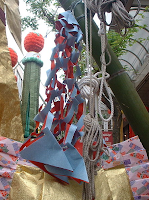It's summertime and firework season in Japan.
Every July/August a lot of fireworks festivals (花火大会, hanabi taikai) are held all over Japan. The fireworks can be small (around 1,000 shots) or very huge(around 39,000 shots) and can attract up to 1,300,000 visitors. Street vendors sell various drinks, Japanese food and held traditional festival games. Visitors are usually dressed in a Yukata (summer Kimono).
These festivals are very popular for companies, as they can act as sponsors.
They usually buy space on the festival’s pamphlet and make announcements during the event. Most of the time companies want to promote their name to local people, in order to develop in that region.
Also foreign companies in or outside Japan, who want to raise awareness, can reach with this kind of promotion a lot of people. Nearly all Japanese will join at least one Hanabi.
In Nagogata a very unique sponsoring was developed. We call it something like “private fireworks sponsorship”. People can sponsor privately to the fireworks committee and then parts of the fireworks will be shot with a personal message, which often include engagement messages.
These events are part of the Japanese culture and for companies really a good and unique promotion platform.
To those of you who haven't been on summer vacation yet: Enjoy!
Edda





































